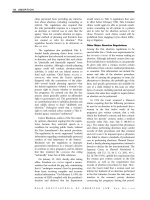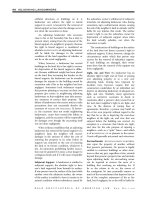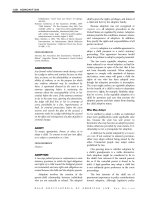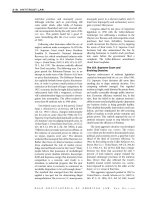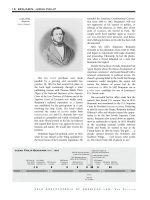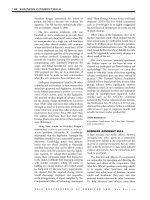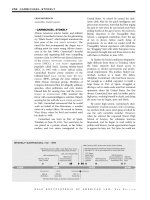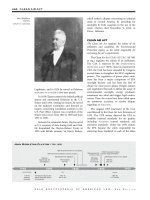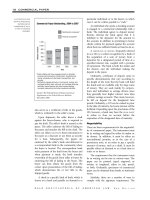Gale Encyclopedia Of American Law 3Rd Edition Volume 11 P4 potx
Bạn đang xem bản rút gọn của tài liệu. Xem và tải ngay bản đầy đủ của tài liệu tại đây (135.35 KB, 10 trang )
of status differences, to which, as has already
been pointed out, segregation makes a material
contribution. Others have a more complicated
relationship to the total social setting. Thus, the
acquisition of an unrealistic basis for self-
evaluation as a consequence of majority group
membership probably reflects fairly closely the
awareness of status differences. On the other
hand, unrealistic fears and hatreds of minority
groups, as in the case of the converse phenom-
enon among minority group members, are
probably significantly influenced as well by the
lack of opportunities for equal status contact.
With reference to the probable effects of
segregation under conditions of equal facilities
on majority group members, many of the social
scientists who responded to the poll in the
survey cited above felt that the evidence is less
convincing than with regard to the probable
effects of such segregation on minority group
members, and the effects are possibly less
widespread. Nonetheless, more than 80 % stated
it as their opinion that the effects of such
segregation are psychologically detrimental to
the majority group members.
13
It may be noted that many of these social
scientists supported their opinions on the effects
of segregation on both majority and minority
groups by reference to one or another or to
several of the following four lines of published
and unpublished evidence.
14
First, studies of
children throw light on the relative priority of
the awareness of status differentials and related
factors as compared to the awareness of
differences in facilities. On this basis, it is
possible to infer some of the consequences of
segregation as distinct from the influence of
inequalities of facilities. Second, clinical studies
and depth interviews throw light on the genetic
sources and causal seque nces of various patterns
of psychological reaction; and, again, certain
inferences are possible with respect to the effects
of segregation per se. Third, there actually are
some relevant but relatively rare instances of
segregation with equal or even superior facili-
ties, as in the cases of certain Indian reserva-
tions. Fourth, since there are inequalities of
facilities in racially and ethnically homogeneous
groups, it is possible to infer the kinds of effects
attributable to such inequalities in the absence
of effects of segregation and, by a kind of
subtraction to estimate the effects of segregation
per se in situations where one finds both
segregation and unequal facilities.
III
Segregation is at present a social reality.
Questions may be raised, therefore, as to what
are the likely consequences of desegregation.
One such question asks whether the inclu-
sion of an intellectually inferior group may
jeopardize the education of the more intelli gent
group by lowering educational standards or
damage the less intelligent group by placing it in
a situation where it is at a marked competitive
disadvantage. Behind this question is t he
assumption, which is examined below, that
the presently segregated groups actually are
inferior intellectuall y.
The available scientific evidence indica tes
that much, perhaps all, of the observable
differences among various racial and national
groups may be adequately explained in terms of
environmental differences.
15
It has been found,
for instance, that the differences between the
average intelligence test scores of Negro and
white child ren decrease, and the overlap of the
distributions increases, proportionately to the
number of years that the Negro children have
lived in the North.
16
Related studies have shown
that this change cannot be explained by the
hypothesis of selective migration.
17
It seems
clear, therefore, that fears based on the
assumption of innate racial differences in
intelligence are not well founded.
It may also be noted in passing that the
argument regarding the intellectual inferiority
of one group as compared to another is, as
applied to schools, essentially an argument for
homogeneous groupings of children by intelli-
gence rather than by race. Since even those who
believe that there are innate differences between
Negroes and whites in America in average
intelligence grant that considerable overlap
13
Deutscher, M. and Chein, I., The Psychological Effects of
Enforced Segregation: A Survey of Social Science Opinion,
J. Psychol., 1948, 26, 259-287.
14
Chein, I., What Are the Psychological Effects of Segrega-
tion Under Conditions of Equal Facilities?, International
J. Opinion and Attitude Res., 1949, 2, 229-234.
15
Klineberg, O., Characteristics of American Negro, 1945;
Klineberg, O., Race Differences, 1936.
16
Klineberg, O., Negro Intelligence and Selective Migration,
1935.
17
Klineberg, O., Negro Intelligence and Selective Migration,
1935.
GALE ENCYCLOPEDIA OF AMERICAN LAW, 3RD E DITION
MILESTONES IN THE LAW BROWN V. BOARD OF EDUCATION 17
U.S. SUPREME
COURT,
OCTOBER 1952
APPENDIX TO
APPELLANTS’
BRIEFS
between the two groups exists, it would follow
that it may be expedient to group together the
superior whites and Negroes, the average whites
and Negroes, and so on. Actually, many
educators have come to doubt the wisdom of
class groupings made homogeneous solely on
the basis of intelligence.
18
Those who are
opposed to such homogeneous grouping believe
that this type of segregation, too, appears to
create generalized feelings of inferiority in the
child who attends a below average class, leads to
undesirable emotional consequences in the
education of the gifted child, and reduces
learning opportunities which result from the
interaction of individuals with varied gifts.
A second problem that comes up in an
evaluation of the possible consequences of
desegregation involves the question of whether
segregation prevents or stimulates interracial
tension and conflict and the corollary question
of whether desegregation has one or the other
effect.
The most direct evidence available on this
problem comes from observations and system-
atic study of instances in which desegregation
has occurred. Comprehensive reviews of such
instances
19
clearly establish the fact that deseg-
regation has been carried out successfully in a
variety of situations although outbreaks of
violence had been commonly predicted. Exten-
sive desegregation has taken place without
major incidents in the armed services in both
Northern and Southern installations and in-
volving officers and enlisted men from all parts
of the country, including the South.
20
Similar
changes have been noted in housing
21
and
industry.
22
During the last war, many factories
both in the North and South hired Negroes on a
non-segregated, non-discriminatory basis.
While a few strikes occurred, refusal by
management and unions to yield quelled all
strikes within a few days.
23
Relevant to this general problem i s a
comprehensive study of urban race riots which
found that race riots occurred in segregated
neighborhoods, whereas there was no violence
in sections of the city where the two races lived,
worked and attended school together.
24
Under certain circumstances desegregation
not only proceeds without major difficulties,
but has been observed to lead to the emergence
of more favorable attitudes and friendlier
relations between races. Relevant studies may
be cited with respect to housing,
25
employ-
ment,
26
the armed services
27
and merchant
marine,
28
recreation agency,
29
and general
community life.
30
Much depends, however, on the circum-
stances under which members of previously
segregated groups first come in contact with
others in unsegregated situations. Available
evidence suggests, first, that there is less
likelihood of unfriendly relations when the
18
Brooks, J. J., Interage Grouping on Trial-Continuous
Learning, Bulletin #87, Association for Childhood Education,
1951; Lane, R. H., Teacher in Modern Elementary School,
1941; Educational Policies Commission of the National
Education Association and the American Association of
School Administration Report in Education For All Amer-
icans, published by the N. E. A. 1948.
19
Delano, W., Grade School Segregation: The Latest Attack
on Racial Discrimination, Yale Law Journal, 1952, 61, 5, 730-
744; Rose, A., The Influence of Legislation on Prejudice;
Chapter 53 in Race Prejudice and Discrimination, Ed. by
Rose, A., 1951; Rose, A., Studies in Reduction of Prejudice,
Amer. Council on Race Relations, 1948.
20
Kenworthy, E. W., The Case Against Army Segregation,
Annals of the American Academy of Political and Social
Science, 1951, 275, 27-33; Nelson, Lt. D. D., The Integration
of the Negro in the U.S. Navy, 1951; Opinions About Negro
Infantry Platoons in White Companies in Several Divisions,
Information and Education Division, U.S. War Department,
Report No. B-157, 1945.
21
Conover, R. D., Race Relations at Codornices Village, Berkeley-
Albany, California: A Report of the Attempt to Break Down the
Segregated Pattern on A Directly Managed Housing Project,
Housing and Home Finance Agency, Public Housing Admin-
istration, Region I, December 1947 (mimeographed); Deutsch,
M. and Collins, M. E., Interracial Housing, A Psychological Study
of A Social Experiment, 1951; Rutledge, E., Integration of Racial
Minorities in Public Housing Projects: A Guide for Local Housing
Authorities on How to Do It, Public Housing Administration,
New York Field Office (mimeographed).
22
Minard, R. D., The Pattern of Race Relationships in the
Pocahontas Coal Field, J. Social Issues, 1952, 8, 29-44;
Southall, S. E., Industry’s Unfinished Business, 1951; Weaver,
G. L-P, Negro Labor, A National Problem, 1941.
23
Southall, S. E., Industry’s Unfinished Business, 1951;
Weaver, G. L-P, Negro Labor, A National Problem, 1941.
24
Lee, A. McClung and Humphrey, N. D., Race Riot, 1943;
Lee, A. McClung, Race Riots Aren’t Necessary, Public Affairs
Pamphlet, 1945.
25
Deutsch, M. and Collins, M. E., Interracial Housing, A
Psychological Study of A Social Experiment, 1951; Merton, R.
K.; West, P. S.; Jahoda, M., Social Fictions and Social Facts:
The Dynamics of Race Relations in Hilltown, Bureau of
Applied Social Research Columbia, Univ., 1949 (mimeo-
graphed); Rutledge, E., Integration of Racial Minorities in
Public Housing Projects; A Guide for Local Housing Authorities
on How To Do It, Public Housing Administration, New York
Field Office (mimeographed); Wilner, D. M.; Walkley, R. P.;
and Cook, S. W., Intergroup Contact and Ethnic Attitudes
in Public Housing Projects, J. Social Issues, 1952, 8, 45-69.
GALE ENCYCLOPEDIA OF AMERICAN LAW, 3RD E DITION
18 BROWN V. BOARD OF EDUCATION MILESTONES IN THE LAW
U.S. SUPREME
COURT,
OCTOBER 1952
APPENDIX TO
APPELLANTS’
BRIEFS
change is simultaneously introduced into all
units of a social institution to which it is
applicable—e.g., all of the schools in a school
system or all of the shops in a given factory.
31
When factories introduced Negroes in only
some shops but not in others the prejudiced
workers tended to classify the desegregated
shops as inferior, “Negro work.” Such objec-
tions were not raised when complete integration
was introduced.
The available evidence also suggests the
importance of consistent and firm enforcement
of the new policy by those in authority.
32
It
indicates also the importance of such factors as:
the absence of competition for a limited
number of facilities or benefits;
33
the possibility
of contacts which permit individuals to learn
about one another as individuals;
34
and the
possibility of equivalence of positions and
functions among all of the participants within
the unsegregated situation.
35
These conditions
can generally be satisfied in a number of
situations, as in the armed services, public
housing developments, and public schools.
IV
The problem with which we have here
attempted to deal is admittedly on the frontiers
of scientific knowledge. Inevitably, there must
be some differences of opinion among us
concerning the conclusiveness of certain items
of evidence, and concerning the particular
choice of words and placement of emphasis in
the preceding statement. We are nonetheless in
agreement that this statement is substantially
correct and justified by the evidence, and the
differences among us, if any, are of a relatively
minor order and would not materially influence
the preceding conclusions.
FLOYD H. ALLPORT
Syracuse, New York
GORDON W. ALLPORT
Cambridge, Massachusetts
CHARLOTTE BABCOCK, M.D.
Chicago, Illinois
VIOLA W. BERNARD, M.D.
New York, New York
JEROME S. BRUNER
Cambridge, Massachusetts
HADLEY CANTRIL
Princeton, New Jersey
ISIDOR CHEIN
New York, New York
KENNETH B. CLARK
New York, New York
MAMIE P. CLARK
New York, New York
STUART W. COOK
New York, New York
BINGHAM DAI
26
Harding, J., and Hogrefe, R., Attitudes of White Depart-
ment Store Employees Toward Negro Co-workers, J. Social
Issues, 1952, 8, 19-28; Southall, S. E., Industry’s Unfinished
Business, 1951; Weaver, G. L-P., Negro Labor, A National
Problem, 1941.
27
Kenworthy, E. W., The Case Against Army Segregation,
Annals of the American Academy of Political and Social
Science, 1951, 275, 27-33; Nelson, Lt. D. D., The Integration
of the Negro in the U.S. Navy, 1951; Stouffer, S., et al., The
American Soldier, Vol. I, Chap. 19, A Note on Negro Troops
in Combat, 1949; Watson, G., Action for Unity, 1947;
Opinions About Negro Infantry Platoons in White Compa-
nies in Several Divisions, Information and Education
Division, U.S. War Department, Report No. B-157, 1945.
28
Brophy, I. N., The Luxury of Anti-Negro Prejudice, Public
Opinion Quarterly, 1946, 9, 456-466 (Integration in
Merchant Marine); Watson, G., Action for Unity, 1947.
29
Williams, D. H., The Effects of an Interracial Project Upon
the Attitudes of Negro and White Girls Within the Young
Women’s Christian Association, Unpublished M. A. thesis,
Columbia University, 1934.
30
Dean, J. P., Situational Factors in Intergroup Relations: A
Research Progress Report. Paper Presented to American
Sociological Society, 12/28/49 (mimeographed); Irish, D.
P., Reactions of Residents of Boulder, Colorado, to the
Introduction of Japanese Into the Community, J. Social
Issues, 1952, 8, 10-17.
31
Minard, R. D., The Pattern of Race Relationships in the
Pocahontas Coal Field, J. Social Issues, 1952, 8, 29-44;
Rutledge, E., Integration of Racial Minorities in Public
Housing Projects; A Guide for Local Housing Authorities on
How to Do It, Public Housing Administration, New York
Field Office (mimeographed).
32
Deutsch, M. and Collins, M. E., Interracial Housing, A
Psychological Study of A Social Experiment, 1951; Feldman,
H., The Technique of Introducing Negroes Into the Plant,
Personnel, 1942, 19, 461-466; Rutledge, E., Integration of
Racial Minorities in Public Housing Projects; A Guide for Local
Housing Authorities on How to Do It, Public Housing
Administration, New York Field Office (mimeographed);
Southall, S. E., Industry’s Unfinished Business, 1951; Watson,
G., Action for Unity, 1947.
33
Lee, A. McClung and Humphrey, N. D., Race Riot, 1943;
Williams, R., Jr., The Reduction of Intergroup Tensions, Social
Science Research Council, New York, 1947; Windner, A. E.,
White Attitudes Towards Negro-White Interaction In An Area
of Changing Racial Composition. Paper Delivered at the
Sixtieth Annual Meeting of the American Psychological
Association, Washington, September 1952.
GALE ENCYCLOPEDIA OF AMERICAN LAW, 3RD E DITION
MILESTONES IN THE LAW BROWN V. BOARD OF EDUCATION 19
U.S. SUPREME
COURT,
OCTOBER 1952
APPENDIX TO
APPELLANTS’
BRIEFS
Durham, North Carolina
ALLISON DAVIS
Chicago, Illinois
ELSE FRENKEL-BRUNSWIK
Berkeley, California
NOEL P. GIST
Columbia, Missouri
DANIEL KATZ
Ann Arbor, Michigan
OTTO KLINEBERG
New York, New York
DAVID KRECH
Berkeley, California
ALFRED MCCLUNG LEE
Brooklyn, New York
R. M. MACIVER
New York, New York
ROBERT K. MERTON
New York, New York
GARDNER MURPHY
Topeka, Kansas
THEODORE M. NEWCOMB
Ann Arbor, Michigan
ROBERT REDFIELD
Chicago, Illinois
IRA DEA. REID
Haverford, Pennsylvania
ARNOLD M. ROSE
Minneapolis, Minnesota
GERHART SAENGER
New York, New York
R. NEVITT SANFORD
Poughkeepsie, New York
S. STANFIELD SARGENT
New York, New York
M. BREWSTER SMITH
New York, New York
SAMUEL A. STOUFFER
Cambridge, Massachusetts
WELLMAN WARNER
New York, New York
ROBIN M. WILLIAMS
Ithaca, New York
Dated: September 22, 1952.
34
Wilner, D. M.; Walkley, R. P.; and Cook, S. W., Intergroup
Contact and Ethnic Attitudes in Public Housing Projects,
J. Social Issues, 1952, 8, 45-69.
35
35. Allport, G. W., and Kramer, B., Some Roots of
Prejudice, J. Psychol., 1946, 22, 9-39; Watson, J., Some Social
and Psychological Situations Related to Change in Attitude,
Human Relations, 1950, 3, 1.
GALE ENCYCLOPEDIA OF AMERICAN LAW, 3RD E DITION
20 BROWN V. BOARD OF EDUCATION MILESTONES IN THE LAW
U.S. SUPREME
COURT,
OCTOBER 1952
APPENDIX TO
APPELLANTS’
BRIEFS
In the Supreme Court of
the United States
October Term, 1952
OLIVER BROWN, MRS. RICHARD LAWTON, MRS.
SADIE EMMANUEL, ET AL.,
APPELLANTS,
VS.
BOARD OF EDUCATION OF TOPEKA, SHAWNEE
COUNTY, KANSAS, ET AL., APPELLEES.
APPEAL FROM THE UNITED STATES DISTRICT
COURT FOR THE DISTRICT OF KANSAS
BRIEF FOR APPELLEES
HAROLD R. FATZER, Attorney General,
PAUL E. WILSON, Asst. Attorney General, Counsel for the
State of Kansas, State House, Topeka, Kansas,
PETER F. CALDWELL, Cou nsel for the Board of
Education of Topek a, Kansas. 512 Capitol Federal Bldg.,
Topeka, Kansas.
k
TABLE OF CONTENTS
I. Preliminary Statement
II. Opinion Below
III. Jurisdiction
IV. Questions Presented
V. The Statute
VI. Statement of the Case
VII. Summary of Argument
VIII. Argument
1. Does a statute which permits but does not
require cities of more than 15,000 popula tion to
maintain separate school facilities for colored
and white students violate the Fourteenth
Amendment to the Constitution of the United
States in a situation where a court has
specifically found that there is no discrimination
or distinction in physical facilities, educational
qualifications of teachers, c urricula or transpor-
tation facilities?
2. Background of Segregation in Kansas
3. The Kansas Decisions
4. The Controlling Principles
5. The Prospect
6. The District Court’s finding of Fact No. VIII is
insufficient to establish appellants right to injunc-
tive relief and to require reversal of the judgment
below
IX. Conclusion
k
I. PRELIMINARY STATEMENT
The issue presented by this case is whether
the Fourteenth Amendment to the Constitution
of the United States is violated by a statute
which permits boards of education in desig-
nated cities to maintain separate elementary
school facilities for the education of white and
colored children.
At the outset, counsel for the appellees desire
to state that by appearing herein they do not
propose to advocate the policy of segregation of
any racial group within the public school system.
We contend only that policy determinations are
matters within the exclusive province of the
legislature. We do not express an opinion as
to whether the practice of having separate
schools of equal facility for the white and colored
races is economically expedient or sociologically
desirable, or whether it is consistent with sound
ethical or religious theory. We do not understand
that these extra-legal questions are now before the
Court. The only proposition that we desire to urge
is that the Kansas statute which permits racial
segregation in elementary public schools in
certain cities of the state does not violate the
Fourteenth Amendment to the Constitution of
the United States as that amendment has been
interpreted and applied by this Court.
II. OPINION BELOW
The opinion of the three-judge District
Court below: (R-238-244) is reported at 98
Fed. Supp. 797.
III. JURISDICTION
The judgment of the court below was
entered on August 3, 1951 (R. 247). On October
1, 1951, appellants filed a petition for appeal (R.
248), and an order allowing the appeal was
entered (R. 251). Probable jurisdiction was
noted on June 9, 1952 (R. 254). Jurisdiction of
this Court rests on Title 28 U. S. C. Sec. 1253
and 2201 (b).
IV. QUESTIONS PRESENTED
1. Does a statute which permits but does not
require cities of more than 15,000 population to
maintain separate school facilities for colored
and white students, violate the Fourteenth
MILESTONES IN THE LAW BROWN V. BOARD OF EDUCATION 21
U.S. SUPREME
COURT,
OCTOBER 1952
BRIEF FOR
APPELLEES
GALE ENCYCLOPEDIA OF AMERICAN LAW, 3RD E DITION
Amendment to the Constitution of the United
States in a situation where a court has
specifically found that there is no discrimi na-
tion or distinction in physical facilities, educa-
tional qualifications of teachers, curricula or
transportation facilities?
2. Is a general finding of the trial court that
segregation is detrimental to colored children and
deprives them of some benefits they would receive
in a racial integrated school sufficient to entitle the
individual colored plaintiffs to an injunction
prohibiting the maintenance of an existing system
of segregated schools, and to require reversal of a
judgment denying such relief?
V. THE STATUTE
The statute under attack in the present
litigation is section 72-1724, General Statutes of
Kansas of 1949, which is quoted hereafter:
“Powers of board; separate schools for white
and colored children; manual training. The
board of education shall have power to elect
their own officers, make all necessary rules
for the government of the schools of such
city under its charge and control and of the
board, subject to the provisions of this act
and the laws of this state; to organize and
maintain separate schools for the education
of white and colored children, including the
high schools in Kansas City, Kansas; no
discrimination on account of color shall be
made in high schools, except as provided
herein; to exercise the sole control over the
public schools and school property of such
city; and shall have the power to establish a
high school or high schools in connection
with manual training and instruction or
otherwise, and to maintain the same as a
part of the public school system of said city.”
VI. STATEMENT OF THE CASE
The appellants here, who are plaintiffs below,
are Negro citizens of the United States and the
State of Kansas, who reside in Topeka, Shawnee
County, Kansas. The infant plaintiffs are children
of common school age. The defendants below
and appellees herein are the duly constituted
governing body and certain administrative offi-
cers of the public school system of Topeka,
Kansas. The State of Kansas has intervened in the
District Court to defend the constitutionality of
the state statute under attack.
Acting pursuant to the authority conferred
by G. S. 1949, 72-1724, supra, the appellee,
Board of Education, many years ago created
within the city of Topeka, which is one school
district, eighteen school areas, and now main-
tains in each of said areas a kindergarten and
elementary school for white children only. (R.
24.) At the same time the present Board of
Education of Topeka and prior boards of
education, acting under same statutory author-
ity, have established and operated in said city
four elementary schools in the same grades for
Negro children. Negro children may attend any
one of said elementary schools that they or their
parents may select. It was stipulated in the
Court below that the Negro schools are located
in neighborhoods in which the population is
predominantly Negro. (R. 31.) The stipulation
also indicates that at the time the action was
brought, the enrollment in the eighteen white
schools w as 6,019, as compared to 658 students
enrolled in the four Negro schools. (R. 37.)
The administration of the entire Topeka
school system is under the Board of Education,
and the same administrative regulations govern
both the white and Negro schools. The Court
found specifically that there is no material
difference in the physical facilities in colored
and white schools; that the educational qualifica-
tions of the teachers and the quality of instruc-
tion in the colored schools are not inferior to,
but are comparable with those in the white
schools; and that the courses of study followed in
the two groups of schools are identical, being
that prescribed by state law. (R. 245.) Also, it was
found that colored students are furnished
transportation to the segregated schools without
cost to the children or their parents. No such
transportation is furnished to the white children
in the segregated schools. (R. 246.)
VII. SUMMARY OF ARGUMENT
1. The Kansas statute which permits cities of
the first class to maintain separate grade school
facilities for colored and white students does not
per se violate the Fourteenth Amendment to the
Constitution of the United States.
The Court below found facilities provided
for Negro children in the city of To peka to be
substantially equal to those furnished to white
children. The appellants, in their specifications
of error and in their brief, do not object to that
finding. Under those circumstances and under
authority of the decisions of the Supreme Court
of the United States, the inferior federal courts,
and the courts of last resort in numerous state
jurisdictions, and particularly the decisions of
the Kansas Supreme Court, the appellants
GALE ENCYCLOPEDIA OF AMERICAN LAW, 3RD E DITION
22 BROWN V. BOARD OF EDUCATION MILESTONES IN THE LAW
U.S. SUPREME
COURT,
OCTOBER 1952
BRIEF FOR
APPELLEES
herein are not denied equal protection of the
laws by virtue of their being required to attend
schools separate from those which white
children are required to attend.
The decision of the court below should be
affirmed.
2. Irrespective of the question of the
constitutionality of the Kansas statute, the trial
court’s findings of fact are insufficient to
establish appellants’ right to injunctive relief
and to require reversal of the judgment below.
The only finding of fact relied upon by
appellants is Finding of Fact No. VIII. That
finding is couched in general language and in
effect simply shows that segregation in the public
schools has a detrimental effect upon colored
children and a tendency to retain or retard their
educational and mental development and to
deprive them of some of the benefits they would
receive in a racially integrated school system.
The finding does not specifically show that any
of the appellants have actually and personally
suffered by reason of segregation in the public
schools of Topeka nor that the mental develop-
ment of any of the appellants in this case has
been retarded; and the finding does not even
purport to show discrimination against the
appellants and in favor of any other students
in the Topeka school system. It no where
discusses the effect of segregation upon children
of any race other than colored children.
Therefore, the District Court’s Finding of Fact
No. VIII fails to show either that the appellants
have suffered any personal harm, or that they are
being deprived of benefits or subjected to
detriments which do not equally apply to other
students in the Topeka school system. Thus, the
appellants have failed to secure findings of fact
sufficient to entitle them to injunctive relief or to
a reversal of the judgment below.
VIII. ARGUMENT
1. Does a statute which permits but does
not require cities of more than 15,000
population to maintain separate school facili-
ties for colored and white students violate the
Fourteenth Amendment to the Constitution
of the United States in a situation where a
court has specifically found that there is no
discrimination or distinction in physical
facilities, educational qualifications of tea-
chers, curricula or transportation facilities?
Appellees contend that only a negative
answer to this question is possible.
Background of segregation in Kansas A
meaningful examination of any statute must
necessarily be made in the light of its context. In
Plessy v. Ferguson, 163 U.S. 357, the Court
comments:
“So far, then, as a conflict with the 14th
Amendment is concerned, the case reduces
itself to the question of whether the statute
is a reasonable regulation, and with
respect to this, there must necessarily be a
large discretion on the part of the legislature.
In determining the question of reasonable-
ness, it is at liberty to act with reference to
the established usages, customs, and tradi-
tions of the people, and with a view to the
promotion of their comfort, and the preser-
vation of the public peace and good order.”
Therefore, we deem it proper to pause
briefly to examine the origins and attitudes of
the people of the State of Kansas.
The birth of the State of Kansas was an
incident of the intersectional struggle that
culminated in the war between the states.
Located midway between the north and the
south, the territory of Kansas was coveted by
both the pro-slavery and free-state elements.
The Kansas-Nebraska Act which announced the
principle of “squatter sovereignty” formally
opened the territory for settlement and resulted
in migration of large numbers of people from
both the north and the south. In these early
settlers were reflected the diverse attitudes and
cultures of the regions from which they came.
While the free-state elements from the north
gained political ascendency, there remained in
Kansas people who, in good faith, believed that
the welfare of both the colored and the white
races required that they live apart from one
another. Migration following the war between
the states followed the same pattern. While
the greatest number came from Illinois, Ohio,
Indiana and other northern states, a consider-
able segment of the population had its origin in
Kentucky, Tennessee and Missouri. (Clark &
Roberts, People of Kansas, 1936, p. 18.)
The early legislatures were faced with the
task of reconciling the divergent attitudes of the
settlers from such varied cultural backgrounds.
The Wyandotte Constitution, under which
the State of Kansas was admitted to the Union,
provided for a system of public education
specifically requiring the legislature to “encour-
age the promotion of intellectual, moral,
scientific and agricultural improvement, by
GALE ENCYCLOPEDIA OF AMERICAN LAW, 3RD E DITION
MILESTONES IN THE LAW BROWN V. BOARD OF EDUCATION 23
U.S. SUPREME
COURT,
OCTOBER 1952
BRIEF FOR
APPELLEES
establishing a uniform system of common
schools and schools of a higher grade, embrac-
ing normal, preparatory, collegiate and univer-
sity departments.” (Const., Art. 6, Sec . 1.) It
is significant that an effort was made in the
Wyandotte convention to obtain a constitu-
tional requirement for the separate education of
Negro children. The proposal was defeated, not
because of objection to the intrinsic policy of
segregation, but because the dominant faction
in the constitutional convention believed that
the power to govern the public schools and to
classify student s therein should rest with the
legislature. At no time was doubt expressed
that the constitutional provision adopted at
Wyandotte would preclude classification of
students on the basis of color (Wyandotte
Constitutional Convention, Proceedings and
Debates, 1859, pp. 171 to 174).
As early as 1862 the power to classify
students was exercised by the enactment of
section 18, article 4, chapter 46, Compiled Laws
of 1862, applying to cities of not less than 7,000
inhabitants. That statute provided:
“The city council of any city under this act
shall make provisions for t he appropriation
of all taxes for school purposes collected
from black or mulatto persons, so that the
children of such persons shall receive the
benefit of all moneys collected by taxation
for school purposes from such persons, in
schools separate and apart from the schools
hereby authorized for the children of white
persons.”
Chapter 18, Laws of 1868, entitled “An Act
to Incorporate Cities of the First Class”
authorized the organization and maintenance
of separate schools for the education of white
and colored children in cities of over 15,000
population. In 1876 the laws of the state
pertaining to the common schools were codified
and embodied in one comprehensive statute.
(Chapter 122.) Article X of this chapter related
to the public schools and cities of the first class,
and provided that all cities of more than 15,000
inhabitants shall be governed thereby. The
provision of the law of 1868 authorizing the
maintenance of separate schools for white and
colored children was omitted from that section
and was thus deemed to have been repealed by
implication. However, in 1879 a statute was
passed (Laws of 1879, Chapter 81) amending
the law relating to cities of the first class and
specifically authorizing the boards of education
therein to organize and maintain separate
elementary schools for the education of white
and colored children. The section was again
amended by Laws of 1905, Chapter 414, and
now appears without further change in G. S.
1949, 72-1724, quoted above.
Two features of the Kansas statute should
be emphasized. In the first place, we invite the
court’s attention to the fact that the statute is
permissive only and does not, as may be inferred
from appellants’ brief, require any board of
education to maintain separate schools for
colored children.
In the second place, it is again pointed out
that the statute applies only to cities of the first
class. Cities of the first class in Kansas include
those cities having a population of more than
15,000 persons. Presently there are 12 cities in
the state so classified. The special provision
affecting only these communities may be
accounted for by reference to the fact that the
Negro population of Kansas is largely urban.
According to the 1950 census, less than four
percent of the total population of Kansas
belongs to the Negro race. However, more than
ninety percent of this colored population lives
in cities classified as urban. Sixty percent of the
total colored population live in the three largest
cities of Kansas City, Wichita and Topeka, and
at least thirty-five percent of this total live in
Kansas City alone. Thus, in enacting a school
segregation statute applicable only to cities of
the first class the Kansas legislature has simply
recognized that there are situations where
Negroes live in sufficient numbers to create
special school problems and has sought to
provide a law sufficiently elastic to enable
Boards of Education in such communities to
handle such problems as they may, in the
exercise of their discretion and best judgment,
deem most advantageous to their local school
system under their local conditions.
The Kansas decisions The Supreme Court
of Kansas has uniformly held that the governing
bodies of school districts in the state may
maintain separate schools for colored children
only when expressly authorized by statute.
(Board of Education v. Tinnon, 26 Kan. 1
(1881); Knox v. Board of Education, 45 Kan.
152, 25 Pac. 616 (1891); Cartwright v. Board of
Education, 73 Kan. 302, 84 Pac. 382 (1906);
Rowles v. Board of Education, 76 Kan. 361, 91
GALE ENCYCLOPEDIA OF AMERICAN LAW, 3RD E DITION
24 BROWN V. BOARD OF EDUCATION MILESTONES IN THE LAW
U.S. SUPREME
COURT,
OCTOBER 1952
BRIEF FOR
APPELLEES
Pac. 88 (1907); Woolridge, et al., v. Board of
Education, 98 Kan. 397, 157 Pac. 1184 (1916);
Thurman-Watts v. Board of Education, 115 Kan.
328, 22 Pac. 123 (1924); Webb v. School District,
167 Kan. 395, 206 Pac. 2d 1066 (1949).
The rationale of each of these cases is
expressed in Thurman-Watts v. Board of Educa-
tion, supra, as follows:
“The power and duty of the school board are
derived exclusively from the statutes. The
school board has no greater power than is
conferred on it by the statutes.”
It is significant that in each of the cases cited
above, the court expressly recognized or con-
ceded that the legislature has power to classify
students in the public schools on the basis of
color. Illustrative of this attitude is the following
statement from Board of Education v. Tinnon,
supra, appearing on p. 16 of the reported
decision:
“For the purpose of this case we shall assume
that the legislature has the power to autho-
rize the board of education of any city or the
officers of any school district to establish
separate schools for the education of white
and colored children, and to exclude the
colored children from the white schools
notwithstanding the Fourteenth Amendment
to the Constitution of the United States;”
In each of the subsequent cases where the
power to segregate was denied by reason of the
absence of statutory authority, the court
specifically recognized that the legislature had
such authority to confer. (See cases above
cited.)
The question of the constitutionality of a
statute, antecedent to but substantially like the
one here under attack, was squarely presented
to the Supreme Court of Kansas in the case of
Reynolds v. Board of Education, 66 Kan. 672, 72
Pac. 274. That was a proceeding in the nature of
mandamus brought against the board of
education of the city of Topeka by a colored
resident. In the action he sought to compel the
board of education to admit his child to a
school maintained for white children only. In
an exhaustive opinion the court found that the
statute which permitted the policy of racial
segregation to be valid and not in violation of
the Fourteenth Amendment to the Constitution
of the United States. The court relied specifically
on the decision of the Supreme Court of the
United States in the case of Plessy v. Ferguson,
supra, and held that where facilities are equal,
the mere fact of separation of races within a
school system does not constitute a violation of
the Fourteenth Amendment to the Constitution
of the United States.
Quoting with approval from the New York
case of People, ex rel., Cisco v. School Board, 161
N. Y. 598, 56 N. E. 81, 48 L. R. A. 115, the Court
said:
“The most that the constitution requires the
legislature to do is to furnish a system of
common schools where each and every child
may be educated; not that all must be
educated in any one school, but that it
shall provide or furnish a school or schools
where each and all may have the advantages
guaranteed by that instrument. If the legisla-
ture determined that it was wise for one class
of pupils to be educated by themselves, there
is nothing in the constitution to deprive it of
the right to so provide. It was the facilities for
and the advantages of an education that it
was required to furnish to all the children,
and not that it should provide for t hem
any particular class of associates while such
education was being obtained.”
And the court found merit in the quoted
portion of the decision in the Massachusetts
case of Roberts v. City of Boston, 5 Cush. 198:
“It is urged that this maintenance of separate
schools tends to deepen and perpetuate the
odious distinction of caste, founded in a
deep-rooted prejudice in public opinion.
This prejudice, if it exists, is not created by
law, and probably cannot be changed by law.
Whether this distinction and prejudice,
existing in the opinion and feelings of the
community, would not be as effectually
fostered by compeling colored and white
children to associate together in the same
schools, may well be doubted; at all events, it
is a fair and proper question for the
committee to consider and decide upon,
having in view the best interests of both
classes of children placed under thier super-
intendence, and we cannot say, that their
decision upon it is not founded on just
grounds of reason and experience, and in the
results of a discriminating and honest
judgment.”
Consistent with its finding that the statute
did not violate the equal protection guarantee of
the Fourteenth Amendment, the Court said on
page 689: “The design of the common-school
system of this state is to instruct the citizen, and
where for this purpose they have placed within
his reach equal means of acquiring an education
with other persons, they have discharged their
duty to him, and he has received all that he is
GALE ENCYCLOPEDIA OF AMERICAN LAW, 3RD E DITION
MILESTONES IN THE LAW BROWN V. BOARD OF EDUCATION 25
U.S. SUPREME
COURT,
OCTOBER 1952
BRIEF FOR
APPELLEES
entitled to ask of the government with respect
to such privileges.”
Finally on page 292 the court holds:
“The act of the legislature of 1879 providing
for the education of white and colored
children in separate schools in cities of the
first class except in the high school is,
therefore, in all respects constitutional and
valid.”
At the same time the Kansas court has
always insisted that facilities must be equal for
all groups. Particularly significant is the case of
Williams v. Parsons, 79 Kan. 202, decided in
1908. There objection was made that the school
provided for colored children was located in
such close proximity to the railroad track s that
such location produced an undue hazard to the
children attending the school. The court stated,
at page 209:
“Having power to maintain separate schools
in cities of the first class, the duty rests upon
the board of education therein to give equal
educational facilities to both white and
colored children in such schools. This
requirement must have a practical interpre-
tation so that it may be reasonably applied to
varying circumstances Where the loca-
tion of a school is such as to substantially
deprive some of the children of the district of
any educational facilities, it is manifest that
this equality is not maintained and the
refusal to furnish such privileges, where it
is practicable to do so, is an abuse of
discretion for which the courts will afford a
remedy.”
A later expression of the Supreme Court of
Kansas is found in Graham v. Board of
Education, 153 Kan. 840, decided in 1941.
There the court said on page 842:
“The authorities are clear that separate
schools may be maintained for the white
and colored races if the educational facilities
provided for each are equal, unless such
separation is in contravention of a specific
state law.”
Again on p. 846 the court comments with
reference to the rule expressed in Reynolds v.
Board of Education, supra:
“The defendants cite the case of Reynolds v.
Board of Education, 66 Kan. 672, 72 Pac. 274.
The rules of law set out in that case are sound
and are applied in this case.”
These cases demonstrate that the Supreme
Court of Kansas has never doubted that G. S.
1949, 72-1724, and its antecedent statutes is
without the scope of the prohibitions imposed
on the legislature by the Fourteenth Amend-
ment to the Constitution of the United States.
The controlling principles The position
taken by the Supreme Court of Kansas in the
cases cited, supra, is sustained by the weight of
the decisions of this Court in Plessy v. Ferguson,
supra, and Gong Lum v. Rice, 275 U.S. 78; and
in numerous decisions of the inferior federal
courts and the appellate courts in other states.
Appellants suggest that the Plessy case is not
applicable to the situation before us. Admit-
tedly, the question presented in the Plessy case
arose out of segregation of white and colored
races in railroad cars and not segregation in the
public schools. However, the decision of the
Court rises above the specific facts in issue and
announces a doctrine applicable to any social
situation wherein the two races are brought into
contact. In commenting upon the purpose and
the limitations of the Fourteenth Amendment
the Court makes the following statement:
“The object of the Amendment was un-
doubtedly to enforce the absolute equality of
the two races before the law, but in the
nature of things it could not have been
intended to abolish distinctions based upon
color, or to enforce social, as distinguished
from political equality, or a commingling of
the two races upon terms unsatisfactory to
either. Laws permitting and even requiring
their separation in places where they are
liable to be brought into contact do not
necessarily imply the inferiority of either race
to the other, and have been generally, if not
universally, recognized as within the compe-
tency of the state legislatures in the exercise
of their police power. The most common
instance of this is connected with the
establishment of separate schools for white
and colored children which has been held to
be a valid exercise of the legislative power
even by courts of States where the political
rights of the colored race have been longest
and most earnestly enforced.” (p. 554.)
Certainly this language refutes appellants’
contention that the Plessy case has no applica-
tion to these facts.
Appellants further state that Gong Lum v.
Rice “is irrelevant to the issues in this case.” This
statement appears to just ify a brief examination
of the facts in the Gong case. Those facts may be
summarized as follows:
The Constitution and statutes of the State of
Mississippi provided for two school systems
in each county. One system was for “white”
GALE ENCYCLOPEDIA OF AMERICAN LAW, 3RD E DITION
26 BROWN V. BOARD OF EDUCATION MILESTONES IN THE LAW
U.S. SUPREME
COURT,
OCTOBER 1952
BRIEF FOR
APPELLEES
